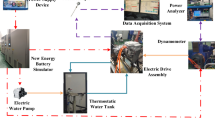Abstract
The specific bench test specified by the product design standard is an important basis for judging whether the vehicle motor meets the requirements. To study the temperature rise characteristics of automotive permanent magnet synchronous motors under bench test conditions. Firstly, the bench condition was taken as the target we need to study, and the finite element method was used to calculate the loss of each part during the bench test condition. Secondly, use this loss as the heat source for temperature field calculation to simulate the temperature field of the motor under bench test conditions. Finally, a bench test platform was built for testing, and the test results and simulation results were compared and analyzed. Studies have shown that in the entire process of changing conditions, the temperature of each component is not the same as the sensitivity to changes in operating conditions. The maximum relative error between simulation and experiment was 9.4%, which verifies the effectiveness of this research method and process, which has certain guiding significance for the design and optimization of vehicle motors.









Similar content being viewed by others
References
Flah A, Khan IA, Agarwal A, Sbita L, Simoes MG (2021) Field-oriented control strategy for double-stator single-rotor and double-rotor single-stator permanent magnet machine: design and operation. Comput Electr Eng 90:1–15
Naoui M, Aymen F, Mouna BH (2019) Inductive charger efficiency under internal and external parameters variation for an electric vehicle in motion. Int J Powertrains 8(4):343–358
Bozhko S, Yang T, Peuvedic J, Arumugam P, Wheeler P (2018) Development of aircraft electric starter-generator system based-on active rectification technology. IEEE Trans Transp Electrif 4(4):985–996
Du G, Xu W, Zhu J, Huang N (2019) Power loss and thermal analysis for high power high speed permanent magnet machines. IEEE Trans Ind Electron 67(4):2722–2733
Jing L, Pan Y, Wang T, Qu R, Cheng PT (2021) Transient analysis and verification of a magnetic gear integrated permanent magnet brushless machine with Halbach arrays. IEEE J Emerg Sel Top Power Electron 99(09):1–9
Yamazaki K, Ishigami H (2009) Rotor-shape optimization of interior-permanent-magnet motors to reduce harmonic iron losses. IEEE Trans Ind Electron 57(1):61–69
Staton D, Boglietti A, Cavagnino A (2005) Solving the more difficult aspects of electric motor thermal analysis in small and medium size industrial induction motors. IEEE Trans Energy Convers 20(3):620–628
Zhang F, Du G, Wang T, Cao W, Kirtley JL (2016) Electromagnetic design and loss calculations of a 1.12-MW high-speed permanent-magnet motor for compressor applications. IEEE Trans Energy Convers 31(1):132–140
Fan J, Zhang C, Wang Z, Dong Y, Nino CE, Tariq AR, Strangas EG (2010) Thermal analysis of permanent magnet motor for the electric vehicle application considering driving duty cycle. IEEE Trans Magn 46(6):2493–2496
Wang T, Zhang Y, Wen F, Gerada C, Liu G, Rui D, Zerun W (2019) Coupling calculation and analysis of three-dimensional temperature and fluid field for high-power high-speed permanent magnet machine. IET Electr Power Appl 13(6):827–832
Wang X, Dai Y, Luo J (2019) Water way design and temperature field analysis of vehicle permanent magnet synchronous motor based on fluid-solid coupling. Trans China Electrotech Soc 1(34):22–29
Jankowski TA, Prenger FC, Hill DD (2010) Development and validation of a thermal model for electric induction motors. IEEE Trans Ind Electron 57(12):4043–4054
Zhang J, Jiang Y (2015) Thermal analysis of constant frequency double rotor permanent magnet generator based on equivalent thermal network method. Trans China Electrotech Soc 30(002):87–97
Cheng S, Li C, Chai F (2012) Analysis of the 3D steady temperature field of induction motors with different cooling structures in mini electric vehicles. Proc CSEE 32(030):82–90
Wang X, Jia Z, Gao P (2014) Coupled electromagnetic-thermal field analysis of out-rotor in-wheel motor. J Tianjin Univ (Sci Technol) 47(10):898–902
Han X, Song C (2020) Research on temperature rise influencing factors and calculation of permanent magnet synchronous motor for vehicle based on magneto-thermal coupling method. Electr Mach Control 24(02):28–35
Zhu X, Wu J, Shi N, Su X, Han L (2018) Dynamic temperature rise calculation for EV drive motor regarding driving condition. Chin J Sci Instrum 39(07):127–133
Li L, Zhang J, Yan H, Yu J (2016) Study on the optimization of thermal conductivity and 3D temperature filed calculation for the high power density motor. Proc CSEE 36(13):3642–3650
Kong XG, Wang FX, Xu YL, Xing JQ (2010) Analysis and calculation of iron losses of high-speed permanent magnet machines. Electr Mach Control 014(009):26–30
Liu W (2019) Research on thermal performance under multi-operating conditions and cooling water-jacket of water-cooled permanent magnet synchronous motor. Beijing Jiaotong University, Beijing
Tai Y, Liu Z (2020) Analysis on three-dimensional transient temperature field of induction motor. Proc CSEE 30(30):114–120
Zhang M, Luo S, Liu X, Li W (2021) The eddy current loss segmentation model of permanent magnet for temperature analysis in high-speed permanent magnet motor. IET Power Electron 1(04):1–9
Zhang Q, Wang W, Huang S, Guo J (2012) Heat transfer simulation of high density permanent magnet motor for vehicles based on fluid-solid coupling method. Electr Mach Control Appl 39(008):1–5
He LG, Shi WJ (2021) Temperature characteristics of vehicle motors under extreme variable working conditions. J Power Electron 21(02):1–8
Acknowledgements
This study is supported by the Graduate Student Innovation Program of Chongqing University of Technology (Grant No: clgycx 20201003), the Key Laboratory of Expressway Construction Machinery of Shaanxi Province Open Fund Project (Grant No: 300102251507), the China Postdoctoral Science Foundation-funded Project (Grant No: 2019M663443), and the Youth Project of Science and Technology Research Program of Chongqing Education Commission of China (Grant No: KJQN201901113).
Author information
Authors and Affiliations
Corresponding author
Additional information
Publisher's Note
Springer Nature remains neutral with regard to jurisdictional claims in published maps and institutional affiliations.
Rights and permissions
About this article
Cite this article
He, L., Shi, W., Xia, X. et al. Research on Temperature Rise Characteristics of Vehicle Motors Under Bench Working Condition. J. Electr. Eng. Technol. 16, 3135–3143 (2021). https://doi.org/10.1007/s42835-021-00853-y
Received:
Revised:
Accepted:
Published:
Issue Date:
DOI: https://doi.org/10.1007/s42835-021-00853-y




